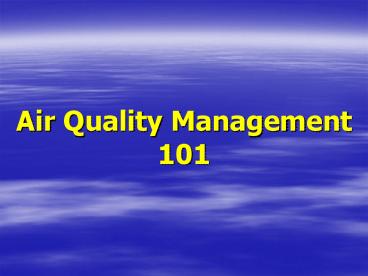Air Quality Management 101 - PowerPoint PPT Presentation
1 / 25
Title:
Air Quality Management 101
Description:
Adopts national air quality standards. Requires use of certain pollution control technologies ... Reducing Air Pollution. Reduce the impacts of government operations ... – PowerPoint PPT presentation
Number of Views:261
Avg rating:3.0/5.0
Title: Air Quality Management 101
1
Air Quality Management101
2
What is Air Pollution?
- Air is
- 78 Nitrogen
- 21 Oxygen
- 1 Other gases (includes pollutant gases)
- Air pollution is
- Gases (sulfur dioxide, chemical vapors)
- Particles (smoke and soot)
- Other contaminants
3
Pollutants in the Air
- Common (Criteria) pollutants
- Ozone
- Particulate matter
- Lead
- Nitrogen dioxide
- Sulfur dioxide
- Carbon monoxide
- Hazardous Air Pollutants (188 substances)
- Benzene
- Perchloroethylene (dry cleaning
solvent)
- Asbestos
- Mercury compounds
4
Ozone
Principal component in Smog
- Ozone is formed in the atmosphere by
- Volatile organic compounds (VOCs)
- Nitrogen oxides (NOx)
- VOCs NOx Light Energy Ozone
(O3)
Ozone season May through September
5
Particulate Matter
Hair cross section (70 mm)
Human Hair (70 µm diameter)
Source M. Lipsett, California Office of
Environmental Health Hazard Assessment
6
What Causes Air Pollution?
- Stationary sources
- Factories, plants
- Area sources
- Dry cleaners, gas stations
- Mobile sources
- Cars, trucks, off-road vehicles,
- construction equipment
- Natural sources
- Volcanoes, forest fires
Photos U.S. Environmental Protection Agency
7
Sources of Pollutants(National averages)
Nitrogen Oxides
Volatile Organic Compounds
Misc. 1
Fuel Combustion (utility and other
non-transportation) 7
Fires 7
Fuel Combustion (utility and other
non-transportation) 5
Miscellaneous 2
Transportation 42
Industrial Processes 45
Industrial Processes 37
Transportation 56
Source U.S. Environmental Protection Agency, 2003
Source U.S. Environmental Protection Agency, 2003
8
Sources of Pollutants(National averages)
Particulate Matter 2.5
Sulfur Dioxide
Transportation 5
Industrial Processes 9
Industrial Processes 6
Area Source Combustion 37
Transportation 21
Fuel Combustion (utility and other
non-transportation) 86
Fuel Combustion (utility and other
non-transportation) 27
Misc. 1
Misc. 9
Source U.S. Environmental Protection Agency, 2003
Source U.S. Environmental Protection Agency, 2000
9
Air Pollution Trends(National averages)
10
Impacts of Air Pollution
Smoky Mountains Good Air Day
Donora, Pennsylvania at noon, 1948
Smoky Mountains Hazy Air Day
Unless noted, photos U.S. Environmental
Protection Agency
11
Health Effects of Air Pollution
Source U.S. Environmental Protection Agency
12
Who is Most at Risk?
- Children
- Elderly
- People with lung or heart diseases and conditions
Photo U.S. Environmental Protection Agency
13
Other Effects of Air Pollution
- Damage to surface water
- Damage to vegetation (crops, trees, etc)
- Damage to buildings and property from acidic
pollutants
Vegetation photo Allen Heagle, USDA ARS North
Carolina State University
Statue and water photos U.S. Environmental
Protection Agency
14
Roles of Government
- Federal government
- State government
- Local government/regional agencies
15
Federal Government
- Adopts national air quality standards
- Requires use of certain pollution control
technologies - Provides technical assistance
- Provides financial assistance
- Oversees of state and local programs
- Conducts/sponsors research
16
Federal GovernmentAir Quality Standards
- National ambient air quality standards set limits
on amounts of pollutants that can be in outdoor
air - Established for criteria pollutants
- Primary standard protects public health
- Secondary standard protects public welfare
(e.g., property, forests, crops, etc.) - Violation of standards may nonattainment
17
State Governments
- Issue air pollution control permits
- Conduct air quality management planning
- Monitor air quality
- Ensure compliance with laws and regs
- Inspect facilities
- Provide technical assistance to regulated sources
(public and private) - Take enforcement actions
18
Local Governments
- Provide similar responsibilities as states in
most areas (where authorized) - Conduct land use/development planning
- Enact ordinances (e.g., open burning ordinances,
school bus idling reduction)
19
Air Quality Monitoring
- Conducted by state or local governments
- Determine compliance with standards
- Examine trends
- Keep citizens informed about air quality in their
area
Photos U.S. Environmental Protection Agency
20
Nonattainment Areas
Source U.S. Environmental Protection Agency
21
School Bus Idling Reduction
- Diesel exhaust contains particulates and other
pollutants - Children breathe more deeply than adults
- Idling reduction saves on fuel cost and engine
wear-and-tear
Photo Clean Air Campaign
22
Local Governments Reducing Air Pollution
- Reduce the impacts of government operations
- Work with others on a regional basis
- Minimize vehicle use
- Improve planning for land use, urban design and
transportation - Conserve energy
- Encourage business, industry and agriculture to
use best practices
23
Who Causes Air Pollution
- People
- Energy consumption
- Home fuel use
- Transportation
- Use of goods and services
24
What Can You Do to Improve Air Quality
- Organize and combine trips/errands
- Carpool, van pool, ride mass transit, telework
- Maintain vehicles properly (tires, filters,
tune-ups) - Conserve energy/electricity
- Use fireplaces sparingly
- Dispose of paints/solvents properly
- Get involved in your community
25
Questions ?































